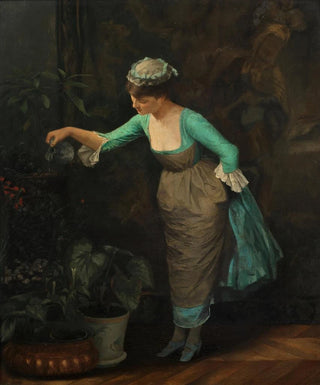Art print | Woman watering flowers - Theodoros Ralli


View from behind

Frame (optional)
In the rich and captivating universe of art, some works manage to capture the very essence of everyday life while revealing unexpected emotional depth. "Woman watering flowers" by Theodoros Ralli is one of those creations that, through its realism and delicacy, transports the viewer into a suspended moment of beauty and simplicity. This piece, both intimate and universal, invites contemplation that goes far beyond a mere depiction of a domestic scene. It evokes the relationship between humans and nature, highlighting the importance of daily gestures, often overlooked, that nourish our existence.
Style and uniqueness of the work
Ralli's style is characterized by striking realism, where every detail is carefully observed and rendered. In "Woman watering flowers," the artist manages to create a warm atmosphere through the use of soft, luminous colors. Natural light plays a crucial role, illuminating the scene and highlighting the textures of the flowers and the protagonist's clothing. This artwork is not limited to a simple representation; it captures a moment of life, where the movement of water watering the flowers seems almost tangible. Ralli, through his refined technique, manages to infuse a soul into his subjects, making them lively and accessible. Each brushstroke tells a story, inviting the viewer to immerse themselves in the intimacy of this moment.
The artist and his influence
Theodoros Ralli, a Greek-born painter active at the end of the 19th century and the beginning of the 20th century, made a notable place for himself in the art world thanks to his undeniable talent and unique vision. Influenced by the artistic currents of his time, he married realism with an almost impressionist sensitivity. Ralli often explored themes related to daily life, highlighting ordinary characters in simple situations, but charged with emotion. His work is marked by a quest for beauty in everyday life, an aspect that resonates particularly in "Woman watering flowers." This approach has inspired

Matte finish

View from behind

Frame (optional)
In the rich and captivating universe of art, some works manage to capture the very essence of everyday life while revealing unexpected emotional depth. "Woman watering flowers" by Theodoros Ralli is one of those creations that, through its realism and delicacy, transports the viewer into a suspended moment of beauty and simplicity. This piece, both intimate and universal, invites contemplation that goes far beyond a mere depiction of a domestic scene. It evokes the relationship between humans and nature, highlighting the importance of daily gestures, often overlooked, that nourish our existence.
Style and uniqueness of the work
Ralli's style is characterized by striking realism, where every detail is carefully observed and rendered. In "Woman watering flowers," the artist manages to create a warm atmosphere through the use of soft, luminous colors. Natural light plays a crucial role, illuminating the scene and highlighting the textures of the flowers and the protagonist's clothing. This artwork is not limited to a simple representation; it captures a moment of life, where the movement of water watering the flowers seems almost tangible. Ralli, through his refined technique, manages to infuse a soul into his subjects, making them lively and accessible. Each brushstroke tells a story, inviting the viewer to immerse themselves in the intimacy of this moment.
The artist and his influence
Theodoros Ralli, a Greek-born painter active at the end of the 19th century and the beginning of the 20th century, made a notable place for himself in the art world thanks to his undeniable talent and unique vision. Influenced by the artistic currents of his time, he married realism with an almost impressionist sensitivity. Ralli often explored themes related to daily life, highlighting ordinary characters in simple situations, but charged with emotion. His work is marked by a quest for beauty in everyday life, an aspect that resonates particularly in "Woman watering flowers." This approach has inspired






